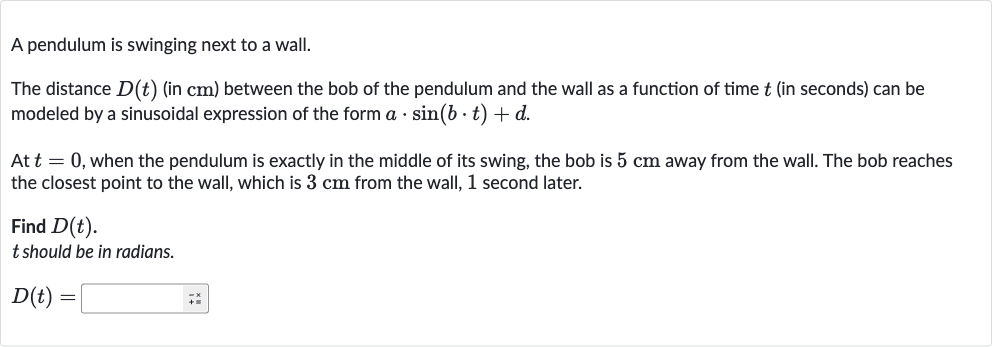AI tutor
Welcome to Bytelearn!
Let’s check out your problem:

A pendulum is swinging next to a wall.The distance (in ) between the bob of the pendulum and the wall as a function of time (in seconds) can be modeled by a sinusoidal expression of the form .At , when the pendulum is exactly in the middle of its swing, the bob is away from the wall. The bob reaches the closest point to the wall, which is from the wall, second later.Find . should be in radians.
Full solution
Q. A pendulum is swinging next to a wall.The distance (in ) between the bob of the pendulum and the wall as a function of time (in seconds) can be modeled by a sinusoidal expression of the form .At , when the pendulum is exactly in the middle of its swing, the bob is away from the wall. The bob reaches the closest point to the wall, which is from the wall, second later.Find . should be in radians.
- Initial Position Calculation: The pendulum is in the middle of its swing at , so the distance from the wall is the average of the maximum and minimum distances. This is the value of in the equation.
- Amplitude Calculation: Since the pendulum is from the wall at , .
- Period Calculation: One second later, the pendulum is at its closest point to the wall, which is . This means the amplitude is the difference between the average distance and the closest distance, so .
- Angular Frequency Calculation: The pendulum reaches its closest point to the wall second later, which is a quarter of the period of the sinusoidal function. Therefore, the period is seconds.
- Sinusoidal Function Determination: To convert the period into radians, we use the formula , where is the angular frequency in radians per second. Solving for gives us .
- Sinusoidal Function Determination: To convert the period into radians, we use the formula , where is the angular frequency in radians per second. Solving for gives us .Substitute with seconds to find : radians per second.
- Sinusoidal Function Determination: To convert the period into radians, we use the formula , where is the angular frequency in radians per second. Solving for gives us .Substitute with seconds to find : radians per second.Now we have all the parameters for the sinusoidal function: cm, radians per second, and cm. The function is therefore .
More problems from Velocity as a rate of change
QuestionGet tutor help
QuestionGet tutor help
QuestionGet tutor help
QuestionGet tutor help
QuestionGet tutor help
QuestionGet tutor help
QuestionGet tutor help
